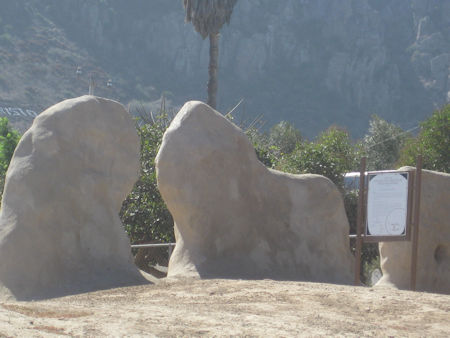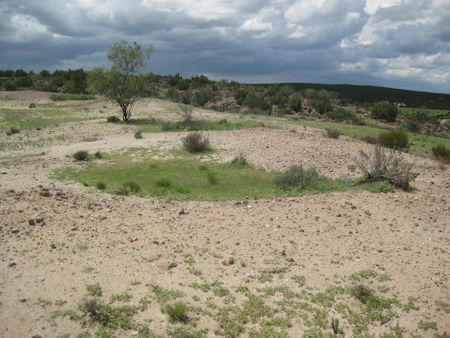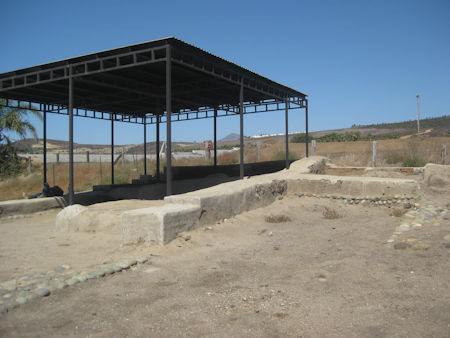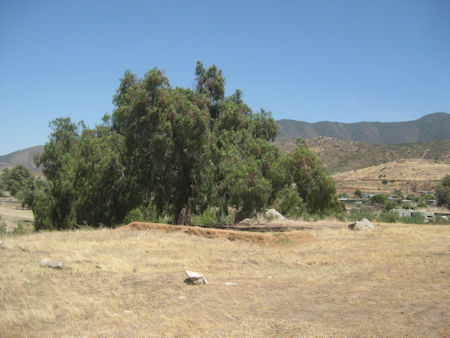 |  |
Dominican Missionary in Baja California, 1814-1840
By David Kier

In the archives of October 12, 1812, Fray Félix Caballero is a 23-year-old of regular stature, dark color, dark brown hair, and dark gray eyes. The young missionary was listed as one of five additional Dominicans that arrived in Mexico and were destined for Baja California. Caballero landed in Mexico at Veracruz on December 19, 1812 and left for Baja California in July 1814.
Caballero’s signature first appears in the Mission San Vicente book, recording a burial on December 15, 1814. In May 1815, Caballero was assigned to replace Padre Tomás Ahumada, at Mission San Miguel. Ahumada had moved the mission north to El Descanso in 1810 after floods destroyed the croplands at San Miguel. The mission was moved back but both sites continued operating together. Félix Caballero was also placed in charge of Mission Santa Catalina in 1819.
1822 was a year of great change in Baja California. The previous year, Mexico defeated Spain in a war for independence. The news finally arrived in Baja California and the Dominicans were required to take an oath of allegiance to the new Mexican Empire. In Loreto on July 7, 1822, oaths were taken, gun salutes were fired, and the bells rang. However, by the end of the year, the number of Dominicans in northern Baja California was cut in half. Padre José Martinez left San Miguel for the southern peninsula thus causing Félix Caballero to divide his time at Santa Catalina with San Miguel. Padre Domingo Luna left Santo Domingo for La Purísima. Padre Francisco Troncoso became very ill and left El Rosario for the mainland (he was also serving San Fernando since 1818).

In 1825, Padre Caballero was made president of the Dominicans in Baja California. By 1829, only two Dominicans were serving northern Baja California. They were Tomás Mansilla at Santo Tomás and Félix Caballero at San Miguel and Santa Catalina. Mansilla also attended to any needs at San Vicente. The other missions on south to San Ignacio had been abandoned. Traveling missionaries would perform services at the abandoned missions they passed by for any Indians still there. The new government of Mexico had no money to support the missions that remained open, so the Dominican padres had to find ways to stay financed on their own.
In 1830, Padre Caballero established his first mission at El Descanso. Ruins of its foundations are partially protected today by a steel awning. Descanso was first developed by Padre Ahumada in 1810 when he moved Mission San Miguel there following devastating flash floods the destroyed San Miguel’s croplands. Ahumada’s New San Miguel mission ruins are now in a cemetery on the south rim of the Descanso valley. At some point, Ahumada returned back to Old San Miguel before he was transferred south in 1815. The year 1817 has been applied to Descanso’s founding in modern books and signage. This was an estimate made in the 1930s by Peveril Meigs and published in his book. Documents available in 1960, published by Reverend Albert Nieser, O.P., have revealed the true dates of these events. Caballero’s 1830 mission was on the north side of the arroyo.

Caballero was becoming quite the business giant following years of very difficult circumstances during the war with Spain that cut supplies to the Spanish missionaries in all the Californias. Farming and cattle raising became a method to obtain supplies by trading with foreign ships. Salt was also bartered, coming from La Salina and San Quintín. Salt was a valuable commodity needed for preserving meat.
In 1834, Caballero decided to concentrate his efforts at a new mission he named Nuestra Señora de Guadalupe. It was founded in June of that year. Located in a valley first known as San Marcos and a dozen miles inland of San Miguel, Mission Guadalupe became Caballero’s capital for the short time the mission was open. Some historians have considered Guadalupe more as the final location for Mission San Miguel rather than a new mission. The missions at San Miguel and Descanso were officially closed when Guadalupe was founded.
The Guadalupe mission had a short life and Caballero was losing support he had with the tribe of Chief Jatiñil. Jatiñil had helped Caballero with building the mission at Descanso in 1830, and Guadalupe in 1834. He also helped to defend the missions of Santa Catalina and Guadalupe which were both attacked in the years that followed. Near the end of 1839 or early in 1840, Mission Santa Catalina was attacked and burned.

Chief Jatiñil grew angry with Padre Caballero over the habit Caballero had of baptizing Indian women. Jatiñil and his braves attacked Mission Guadalupe, killed a soldier, and came into the mission to get Padre Caballero. The priest hid in the choir loft under the dress of María Gracia, who felt sorry for the Dominican padre. Jatiñil left the church after questioning María if she had seen Father. Caballero became so fearful that he left the Frontera (northern Baja California) in great haste. He would request the services of two men he knew to round up his private herd of 1,915 head of cattle and bring them south to his new home at San Ignacio.
Padre Caballero’s story comes to an end on August 3, 1840 at San Ignacio. After drinking his customary cup of chocolate following Mass, he began to feel sharp pains in his stomach. He died a few hours later. His death did not seem to raise any concern with the local judge, Don Ventura Arce, nor that of Frontier comandante, Don José Antonio Garraleta. The government officials were becoming quite suspicious of the Dominicans and wanted all too well to be done with them on the peninsula.
Obviously, there is more to this story!
About David
David Kier is a veteran Baja traveler, author of 'Baja California - Land Of Missions' and co-author of 'Old Missions of the Californias'. Visit the Old Missions website.

Fair price. Webpage could be improved.

Was so easy to purchase our insurance from Baja Bound, I am a senior and had no issues at all!

super easy to complete paperwork. immediate documentation sent.